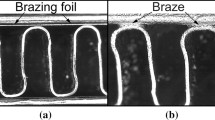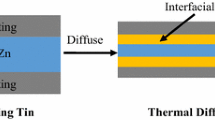Abstract
Brazing is a widely used process to improve the performance of steels used in automotive applications. The substrate material is often exposed to harsh conditions in these applications and may affect the service life of the component. Reactive boride brazing aims to improve the mechanical properties of the substrate material by forming a ceramic-metal composite coating in a single-step process in situ. In this study, sintered Ancor 4300 low-alloy steel is used as the substrate with chromium-rich braze and chromium-lean braze materials. The mechanical properties of the brazed samples were studied in detail using microindentation hardness measurements and the transverse rupture test. The results indicate that the brazed superlayer has a 10 times higher hardness. There was a significant improvement in the transverse rupture strength of the steel brazed with the chromium-rich boride as compared to the pure substrate material. In an effort to reduce processing time, green compacts of the substrate were also directly brazed and yielded favorable results.













Similar content being viewed by others
References
J.R. Tinklepaugh and W.B. Crandall, eds.: Cermets, Reinhold, London, 1960, pp. 41–149.
B. Palanisamy and A. Upadhyaya: Wear, 2009, vol. 266, pp. 1058–65
K. Sivaraman, A. Griffo, and R.M. German: Adv. Powder Metall. Part. Mater., 1997, vol. 2, pp. 14.159–14.173.
S.P. Gordienko: Powder Metall. Met. Ceram., 2002, vol. 41, pp. 169–72.
Y. Yamasaki: J. Jpn. Soc. Powder Powder Metall., 1995, vol. 42 (4), pp. 438–42.
T. Ide, K. Nakano, and K. Takagi: J. Jpn. Soc. Powder Powder Metall., 1992, vol. 39 (4), pp. 247–53.
R. Slattery, P. King, and F. Hanejko: Proc. PM 2 Tec, MPIF, Montreal, PQ, Canada, 2005
P. King: Proc. PM2004 World Congr. Exhib., EPMA, Vienna, Austria, 2004.
K. Takagi, M. Komai, T. Ide, T. Watanabe, and Y. Kondo: Int. J. Powder Metall., 1987, vol. 23 (3), pp. 157–61.
MPIF Standard 41, Method for Determination of Transverse Rupture Strength of Powder Metallurgy Materials, Standard Test Methods for Metal Powders and Powder Metallurgy Products, Metal Powder Industries Federation, Princeton, NJ, 2002.
K. Takagi: Mater. Chem. Phys., 2001, vol. 67, pp. 214–19.
J.C. Russ: Fundamentals of Energy Dispersive X-Ray Analysis, Butterworth, Kent, United Kingdom, 1984, p. 308.
Author information
Authors and Affiliations
Corresponding author
Additional information
Manuscript submitted May 6, 2010.
Rights and permissions
About this article
Cite this article
Palanisamy, B., Upadhyaya, A. Reactive Boride Brazing on Low-Alloy Automotive Grade Steel. Metall Mater Trans A 42, 3417–3424 (2011). https://doi.org/10.1007/s11661-011-0754-4
Published:
Issue Date:
DOI: https://doi.org/10.1007/s11661-011-0754-4




